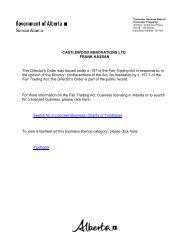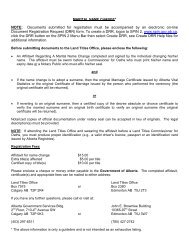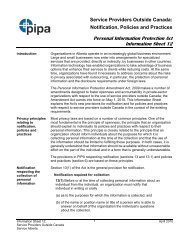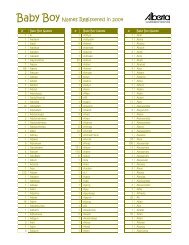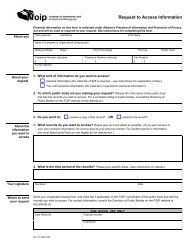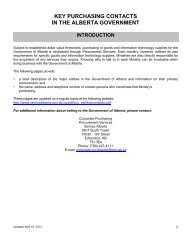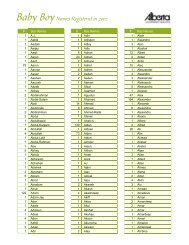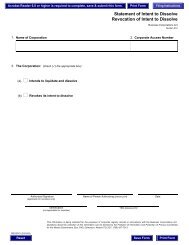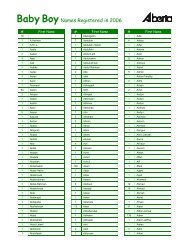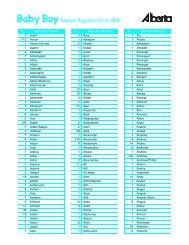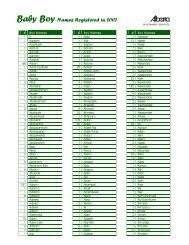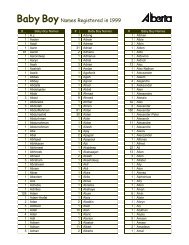A Workbook for Non-Profit Organizations - Service Alberta
A Workbook for Non-Profit Organizations - Service Alberta
A Workbook for Non-Profit Organizations - Service Alberta
Create successful ePaper yourself
Turn your PDF publications into a flip-book with our unique Google optimized e-Paper software.
Protecting Personal In<strong>for</strong>mationA <strong>Workbook</strong> <strong>for</strong> <strong>Non</strong>-<strong>Profit</strong> <strong>Organizations</strong>Discussion Draft, March 2010
ContentsGetting Started........................................................................................................ 11. Know your status ................................................................................... 22. Know what you have.............................................................................. 33. Know why you have it ............................................................................ 44. Choose a privacy contact person ........................................................... 85. Get consent ............................................................................................ 96. Employees and volunteers................................................................... 137. Safeguard personal in<strong>for</strong>mation .......................................................... 14Access Requests.................................................................................................... 17Other Privacy Acts................................................................................................. 18Understanding the Language of Privacy............................................................... 19Sample Privacy Policy............................................................................................ 20Sample Privacy Statement .................................................................................... 25Other Resources.................................................................................................... 26
Getting StartedThis workbook will guide you through the process of documenting the personal in<strong>for</strong>mation yourorganization collects and the purposes <strong>for</strong> collecting it. The workbook will assist you in addingappropriate notice and consent statements to your organization’s <strong>for</strong>ms. You will also find in<strong>for</strong>mationon an individual’s right to access his or her personal in<strong>for</strong>mation from organizations that are subject toPIPA and in<strong>for</strong>mation on other useful resources.For brevity, in this workbook the term “staff” will be used to mean paid employees and volunteers. Theterm “client” will be used to refer to clients, customers and donors, as well as members, of the nonprofitorganization.The workbook outlines requirements <strong>for</strong> non‐profit organizations that are required to comply with PIPA.It also includes best practices that organizations may voluntarily decide to follow to protect the personalin<strong>for</strong>mation of staff and clients.After completing this workbook you should be able to write a consent statement and notice <strong>for</strong> the<strong>for</strong>ms your organization uses to collect personal in<strong>for</strong>mation. You should also be able to draft a privacypolicy or privacy statement that covers the personal in<strong>for</strong>mation of clients and staff. You will haveassessed your organization’s practices <strong>for</strong> keeping in<strong>for</strong>mation safe and know how to improveprotection of personal in<strong>for</strong>mation.Page 1
1. Know your statusThe majority of non‐profit organizations in <strong>Alberta</strong> are not required to comply with PIPA. It is importantto know whether your organization is subject to the Act. If your organization is subject to the Act, then itmust comply with PIPA when collecting, using, disclosing, and safeguarding personal in<strong>for</strong>mation. Itmust also respond to requests from individuals to access records containing personal in<strong>for</strong>mation aboutthem, and do this within the time frames set out in the Act.If your organization is not required to comply with the Act, you may nevertheless choose to adoptcertain best practices to protect the personal in<strong>for</strong>mation in your care.Worksheet 1Is your organization subject to PIPA?1. Is your organization• incorporated under <strong>Alberta</strong>’s Societies Act,• incorporated under <strong>Alberta</strong>’s Agricultural Societies Act, or• registered under Part 9 of <strong>Alberta</strong>’s Companies Act?YES. Go to question 2.NO. Your organization is fully subject to PIPA. (Go to next page.)2. Does your organization• operate a private school (as defined by the School Act),• operate an early childhood services program (as defined by the School Act), or• operate a private college (as defined by the Post‐secondary Learning Act)?YES. Your organization is subject to PIPA <strong>for</strong> the collection, use and disclosureof personal in<strong>for</strong>mation <strong>for</strong> that operation.NO. Go to question 3.3. Does your organization sell, barter or lease a membership list, donor list, or other fundraisingor client, volunteer or employee list?YES. Your organization is subject to PIPA <strong>for</strong> the collection, use and disclosureof personal in<strong>for</strong>mation on that list.NO. Go to question 4.4. Does your organization engage in any other “commercial activity”? For example, areyou operating a day care centre or a fitness centre, or offering training or sellingproducts <strong>for</strong> fees like those charged by the <strong>for</strong>‐profit sector?YES. Your organization is subject to PIPA <strong>for</strong> the collection, use and disclosureof the personal in<strong>for</strong>mation connected to the commercial activity.NO. Your organization is not subject to PIPA. Your organization may choose toadopt best practices to protect the personal in<strong>for</strong>mation of your clientsand staff.Page 2
Now that you know what personal in<strong>for</strong>mation you collect, and the purposes <strong>for</strong> collecting personalin<strong>for</strong>mation, you should look at whether the in<strong>for</strong>mation and purposes match each other.If your organization collects personal in<strong>for</strong>mation <strong>for</strong> several programs, it might be easiest to match thein<strong>for</strong>mation to each program. Here is an example from a community league that runs a sports league <strong>for</strong>children, and runs a raffle <strong>for</strong> fundraising.ActivityRegistering participants,administering teamsFundraising (raffle)Personal in<strong>for</strong>mation(Describe in<strong>for</strong>mation)Name of childName of parent/guardianContact in<strong>for</strong>mationBirth date of childNameTelephone numberAddressPurpose(List why you need it)Creating team lists, contact lists <strong>for</strong> coachesPlacing a child on an age‐appropriate teamContacting the winnersActivityWorksheet 3BMatch it upPersonal In<strong>for</strong>mation(Describe in<strong>for</strong>mation)Purpose(List why you need it)Is there any personal in<strong>for</strong>mation that you collect where you could not identify a good reason <strong>for</strong>collecting it? If you cannot link the in<strong>for</strong>mation to a purpose, consider whether you should be collectingit. PIPA requires organizations to collect only what they reasonably need.Page 5
If you have determined that you do not really need the in<strong>for</strong>mation, what do you do? Stop collecting it.Change your <strong>for</strong>ms so you’re not asking <strong>for</strong> the in<strong>for</strong>mation, or cross out that section of the <strong>for</strong>m untilthe <strong>for</strong>m is revised.You may also want to remove unnecessary in<strong>for</strong>mation from current files. This is especially important ifthe in<strong>for</strong>mation is sensitive (e.g. Social Insurance Numbers, medical in<strong>for</strong>mation). Most organizationsclean up their files periodically and it is acceptable to plan to remove unnecessary in<strong>for</strong>mation duringthe periodic clean‐ups.Be<strong>for</strong>e you get rid of the personal in<strong>for</strong>mation, make sure you have proper processes <strong>for</strong> securelydestroying the in<strong>for</strong>mation: shred paper files (use a cross‐cut shredder) and permanently deleteelectronic files. The section of this workbook on safeguards will make some suggestions <strong>for</strong> destroyingrecords.Worksheet 3CList the “leftovers”ActivityPersonal In<strong>for</strong>mation(Describe in<strong>for</strong>mation)Action PlanDelete from <strong>for</strong>mDelete from current fileDelete from <strong>for</strong>mDelete from current fileDelete from <strong>for</strong>mDelete from current fileDelete from <strong>for</strong>mDelete from current fileDelete from <strong>for</strong>mDelete from current file<strong>Organizations</strong> subject to PIPA can keep personal in<strong>for</strong>mation <strong>for</strong> as long as the in<strong>for</strong>mation is needed <strong>for</strong>legal or business purposes. Personal in<strong>for</strong>mation that your organization no longer needs (e.g. contactin<strong>for</strong>mation <strong>for</strong> <strong>for</strong>mer clients or staff) must be securely destroyed after a reasonable amount of time –one year is a good guideline, but you might have legal reasons <strong>for</strong> keeping certain in<strong>for</strong>mation (such asfinancial or tax records) <strong>for</strong> a longer time. Disposing of in<strong>for</strong>mation that is no longer needed is a goodpractice <strong>for</strong> any organization.How will your organization determine when to get rid of personal in<strong>for</strong>mation that is no longer needed?One way is to have a dedicated spot – file cabinet <strong>for</strong> paper files, or a specific place on your hard drive ornetwork – <strong>for</strong> “inactive” in<strong>for</strong>mation to go. Date the file according to when you “shelved” it. If thein<strong>for</strong>mation remains inactive (e.g. <strong>for</strong> a year), then destroy it using your safe‐destruction processes.Set a schedule <strong>for</strong> reviewing the inactive file <strong>for</strong> “past due” dates.Page 6
Worksheet 3DPlan to dispose of the “leftovers”“Inactive” FileFile location/name(e.g. “Old members” ‐ paper file)Action PlanReview date: _____________________________Destroy after ___ months (e.g. 12, 18)Destruction method: _______________________File location/nameReview date: _____________________________Destroy after ___ monthsDestruction method: _______________________File location/nameReview date: _____________________________Destroy after ___ monthsDestruction method: _______________________File location/nameReview date: _____________________________Destroy after ___ monthsDestruction method: _______________________File location/nameReview date: _____________________________Destroy after ___ monthsDestruction method: _______________________File location/nameReview date: _____________________________Destroy after ___ monthsDestruction method: _______________________File location/nameReview date: _____________________________Destroy after ___ monthsDestruction method: _______________________File location/nameReview date: _____________________________Destroy after ___ monthsDestruction method: _______________________Page 7
4. Choose a privacy contact personWhen an organization subject to PIPA collects personal in<strong>for</strong>mation from an individual, the organizationmust provide a contact person to whom questions can be directed about the collection. An organizationthat is not subject to PIPA should consider having a privacy contact person as a best practice.In a small organization, it may be easiest to make one person responsible <strong>for</strong> receiving questions aboutthe personal in<strong>for</strong>mation your organization collects.The “privacy contact person” can be a paid employee, a volunteer or a board member. Many individualshave some experience with privacy issues, through their roles as employees, customers, or as parentsinteracting with the school system. The contact person needs to have a basic understanding of theorganization’s privacy practices in order to respond appropriately to questions from the public.Also, employees and volunteers should know who the privacy contact person is, so that they can directquestions to that person.Most organizations assign the privacy contact duties to a particular position in their organization (e.g.CEO, board secretary, office manager) rather than naming a particular person. If you do this, you do nothave to update your privacy contact in<strong>for</strong>mation whenever you have a change in personnel.Worksheet 4Our privacy contactPrivacy contact person <strong>for</strong>[insert name of your organization]Position titlePhoneFax [optional]Email [optional]The phone number can be a home, business or cell number; callers should be able to leave amessage if the phone is not answered.Page 8
5. Get consent<strong>Organizations</strong> subject to PIPA need consent to collect, use and disclose personal in<strong>for</strong>mation aboutclients, unless the Act says otherwise. The consent process <strong>for</strong> these organizations is explained below.The use of consent by organizations not subject to PIPA is discussed on page 10. Consent is not normallyrequired when dealing with the personal in<strong>for</strong>mation of employees and volunteers; this is discussed onpage 13.<strong>Organizations</strong> subject to PIPAWhen obtaining consent under PIPA, you must notify your clients of the in<strong>for</strong>mation you collect, andhow you use it. You must also give your clients the name and contact in<strong>for</strong>mation of your privacycontact person in case they have questions. This notice can be included on a membership application orregistration <strong>for</strong>m, or may be given orally.Obtaining express consent is the highest standard. You may obtain express consent in writing or orally. Ifthe in<strong>for</strong>mation is sensitive, it is a good idea to get consent in writing or to make a note that you asked<strong>for</strong> and received oral consent. Sensitive in<strong>for</strong>mation includes: Social Insurance Numbers, medicalin<strong>for</strong>mation, financial in<strong>for</strong>mation, reference checks, and date of birth together with name and address.Your organization may, at times, collect in<strong>for</strong>mation <strong>for</strong> one purpose and want to use it <strong>for</strong> anotherpurpose later on. If so, you must obtain consent <strong>for</strong> that other purpose. For example, a sports facilitycollects an individual’s contact in<strong>for</strong>mation at the time of registration; the facility might want to use thatin<strong>for</strong>mation to promote other unrelated programs. The facility will need to obtain consent <strong>for</strong> thatsecond purpose.If your organization wants to disclose personal in<strong>for</strong>mation outside of the organization <strong>for</strong> an unrelatedpurpose, the organization will need consent to do so.You can often obtain consent <strong>for</strong> all these different purposes at the same time – when you initiallycollect the in<strong>for</strong>mation.In some situations, it is obvious what in<strong>for</strong>mation is being collected and why. For example, if a clienthands you a credit card to pay <strong>for</strong> her sports facility membership fee, you do not need to tell her thatyou are collecting her credit card in<strong>for</strong>mation to process the payment! In this situation, there is impliedconsent to use the credit card in<strong>for</strong>mation <strong>for</strong> that purpose. When can you rely on implied consent?You may use implied consent if:• a client voluntarily gives you in<strong>for</strong>mation, and• the reason you need the in<strong>for</strong>mation is obvious, and• it is reasonable in that situation to volunteer the in<strong>for</strong>mationYou need to obtain consent <strong>for</strong> each purpose. Obtaining consent to use personal in<strong>for</strong>mation <strong>for</strong>enrolment does not allow you to use the same in<strong>for</strong>mation <strong>for</strong> marketing purposes later on – evenif it is the same in<strong>for</strong>mation.Page 9
<strong>Organizations</strong> not subject to PIPA<strong>Organizations</strong> that are not subject to PIPA do not have to follow the consent rules in PIPA whencollecting personal in<strong>for</strong>mation. It may not be practical <strong>for</strong> these organizations to follow the sameconsent process as organizations subject to PIPA. As a best practice, organizations not subject to PIPAmay want to provide an explanation or notice to clients of how the organization normally uses anddiscloses the personal in<strong>for</strong>mation it collects.An organization considering implementing a consent process should obtain legal advice be<strong>for</strong>e doing so.Your organization might need to use or disclose personal in<strong>for</strong>mation <strong>for</strong> unexpected purposes, orpurposes unrelated to the normal operations of your organization, that were not listed on your consent<strong>for</strong>m or notice.<strong>Organizations</strong> subject to PIPA have the benefit of the provisions in PIPA <strong>for</strong> circumstances where itwould be unreasonable or impractical to obtain consent (e.g. when collecting a debt, disclosingin<strong>for</strong>mation to a government department, notifying others in an emergency, or carrying out aninvestigation). <strong>Organizations</strong> not subject to PIPA cannot rely on these provisions; <strong>for</strong> this reason, theremay be situations where obtaining consent would be problematic.At the same time, there may be situations where it could be appropriate to obtain consent, particularlywhen the disclosure of personal in<strong>for</strong>mation is <strong>for</strong> a discretionary purpose, that is, not necessary <strong>for</strong> theprogram or service <strong>for</strong> which the in<strong>for</strong>mation was collected. For example, an organization may wish todisclose the mailing addresses of its team members to a sports retailer that wants to provide a discountcoupon to team members in exchange <strong>for</strong> receiving the mailing addresses <strong>for</strong> marketing purposes.Because this disclosure is optional, the team organization may wish to obtain written consent to disclosethe addresses to the retailer.Your legal advisor can assist you in determining when your organization should consider obtainingconsent and what needs to be included in a consent <strong>for</strong>m.Worksheet 5AForms your organization uses to collect personal in<strong>for</strong>mationNotice of the purposes <strong>for</strong> which an organization collects personal in<strong>for</strong>mation, and a consentstatement, if needed, can be included in the <strong>for</strong>ms the organization uses to collect personalin<strong>for</strong>mation.List the <strong>for</strong>ms your organization uses to collect personal in<strong>for</strong>mation.Membership applicationRegistration <strong>for</strong>m <strong>for</strong> [specify]Other:Other:Other:Other:Other:Page 10
Worksheet 5BSample notice and consent statementsA consent <strong>for</strong>m states what in<strong>for</strong>mation will be collected, sets out the purpose(s) <strong>for</strong> collectingit, and asks the individual to positively authorize the collection <strong>for</strong> those specific purposes.Select the purposes that apply to your organization’s activities. Sample wording is providedbut should be modified to reflect your organization’s way of doing business.Maintain the membership list/provide member benefitsWe require the above in<strong>for</strong>mation to ensure that our membership list is current and tosend you in<strong>for</strong>mation about our programs and services, as well as renewal notices.Membership in our local branch requires membership in the provincial chapter; we willpass on your in<strong>for</strong>mation to the provincial chapter.Register participants <strong>for</strong> trainingWe require the above in<strong>for</strong>mation <strong>for</strong> registration and administration of this trainingsession. In<strong>for</strong>mation may be used <strong>for</strong> program evaluation.Register individuals in a sports programWe require the above in<strong>for</strong>mation to register you/your child in the sports program. Thein<strong>for</strong>mation will be used to place you/your child into the appropriate category and team,to create team contact lists <strong>for</strong> coaches and participants, and to maintain an emergencycontact list <strong>for</strong> coaches.Medical concernsThe medical in<strong>for</strong>mation you have provided about your child will be given to thevolunteers supervising the children, to assist them in recognizing a medical emergencyand to call <strong>for</strong> necessary assistance.Driving recordThe driver’s abstract will be provided to our organization’s insurance provider in order toprovide insurance coverage on the person driving the organization’s vehicles.Other purposes[Add the in<strong>for</strong>mation <strong>for</strong> your privacy contact person and obtain a signature]For further in<strong>for</strong>mation, contact __________________________ [Privacy contact person]I consent to the collection of my/my child’s personal in<strong>for</strong>mation <strong>for</strong> the purposes statedabove.SignatureName (print)Date ___________________________________A child under the age of 18 can provide consent if he or she understands the nature andconsequences of giving consent; otherwise a parent or guardian can provide consent.Page 11
Sample notice <strong>for</strong> sports registration used by a community leagueThe in<strong>for</strong>mation collected above will be used to register the participant in the organization’s sportsleague. The in<strong>for</strong>mation will be used by staff and the coach to assign the participant to a team, tocontact parents/guardians concerning the game schedule and changes, and to contact individuals asnecessary in the case of an emergency.For further in<strong>for</strong>mation, contact our office manager at 780‐555‐5555 or privacy@league.caPlease include my name, my child’s name and contact in<strong>for</strong>mation in the team list that will bedistributed to other parents.Sample script used by staff of a community league <strong>for</strong> accepting registrationsover the telephoneThe personal in<strong>for</strong>mation that I will be asking you <strong>for</strong> will be used to register the participant in theorganization’s sports league. The in<strong>for</strong>mation will be used by staff and the coach to assign theparticipant to a team, to contact parents/guardians concerning the game schedule and changes, and tocontact individuals as necessary in the case of an emergency.[Collect personal in<strong>for</strong>mation]If you need any additional in<strong>for</strong>mation about our privacy policies, you can contact our office manager at780‐555‐5555 or privacy@league.caFor the convenience of parents, the organization compiles a team list that includes the parent’s name,your child’s name and contact in<strong>for</strong>mation to distribute to other parents. Would you like yourin<strong>for</strong>mation to be included in the team list? Yes/NoName of person giving consentParent/Guardian □Name of staff memberDate in<strong>for</strong>mation collected ______________________________Page 12
6. Employees and volunteersAn organization subject to PIPA does not have to obtain consent from employees or volunteers tocollect, use or disclose their personal employee in<strong>for</strong>mation. Notice is enough if the in<strong>for</strong>mation isrelated to establishing, managing, or terminating the employment or volunteer relationship. Noticeshould be given be<strong>for</strong>e the in<strong>for</strong>mation is collected. Giving notice means telling your employees andvolunteers what in<strong>for</strong>mation you collect, use or disclose and why.Under PIPA, your organization can collect, use or disclose that in<strong>for</strong>mation without consent, with twoconditions:• the purpose is related to the employees’ or volunteers’ work (consent is required <strong>for</strong> otherpurposes); and• you tell (provide notice to) your employees or volunteers about the collection, use or disclosure,along with the purposes.If the in<strong>for</strong>mation is not reasonably required <strong>for</strong> employment or volunteer work purposes, theorganization must follow the rules in PIPA regarding consent.An example of an employee notice is provided in the sample privacy policy at the end of the workbook.An organization that is not subject to PIPA may decide, as a best practice, to give notice of its purposes<strong>for</strong> collecting, using or disclosing the personal in<strong>for</strong>mation of employees and volunteers when theorganization needs to collect, use or disclose that in<strong>for</strong>mation (i.e. it is not optional). For example, anorganization must report certain in<strong>for</strong>mation of employees to the Canada Revenue Agency, or to theorganization’s insurance benefit provider. In these circumstances, the notice would in<strong>for</strong>m theemployee or volunteer why the personal in<strong>for</strong>mation was being disclosed and to whom.In other circumstances, an organization may decide to allow employees and volunteers to choosewhether their personal in<strong>for</strong>mation is collected, used or disclosed <strong>for</strong> a particular purpose. For example,the organization may give employees a choice about whether to be added to another organization’smailing list or whether to have their photographs posted on the organization’s website.Worksheet 6Purposes <strong>for</strong> collecting personal employee in<strong>for</strong>mationAssessing or evaluating qualifications of potential staffDeducting income tax and making other payroll deductions (<strong>for</strong> paid employees)Establishing training and development requirementsOther:Other:Other:Other:Other:Page 13
7. Safeguard personal in<strong>for</strong>mation<strong>Organizations</strong> subject to PIPA must protect the personal in<strong>for</strong>mation the organization has about clientsand staff by using reasonable safeguards. <strong>Organizations</strong> not subject to PIPA should also, as a bestpractice, protect the personal in<strong>for</strong>mation of their clients and staff.In determining what safeguards are reasonable <strong>for</strong> your organization, you will want to consider howsensitive the in<strong>for</strong>mation is. All personal in<strong>for</strong>mation should be protected from loss, theft, andinappropriate use or disclosure, but in<strong>for</strong>mation like credit card numbers, Social Insurance Numbers,<strong>Alberta</strong> health care numbers, driver’s licence numbers and birth dates can be used to cause harm if theyare lost or stolen.Common‐sense security practices• File cabinets should be locked when unattended. Computers should have password protection tolimit access to files containing in<strong>for</strong>mation about staff and clients. More sensitive in<strong>for</strong>mation willrequire additional safeguards.• Limit access to personal in<strong>for</strong>mation. Only those staff who need access to the in<strong>for</strong>mation shouldhave a key to the file cabinet or know computer passwords.• The best safeguard is to not collect or keep more in<strong>for</strong>mation than you need. For example, if youneed to verify a child’s age <strong>for</strong> a program, consider making a note on the registration <strong>for</strong>m statingthat the age was verified by viewing a birth certificate (or relevant document) instead of keeping acopy of the certificate on file.Many of the security tips in the next worksheet will also ensure the security of your organization’sbusiness assets and records (e.g. computers and financial accounts).Page 14
Worksheet 7Security practicesWe keep records in paper filesLocked file cabinets and desk drawers protect in<strong>for</strong>mation in paper files.Keys are only provided to staff who need access to the files to per<strong>for</strong>m their work.Paper files are cross‐cut shredded (or otherwise destroyed) be<strong>for</strong>e being disposed of.The Edmonton Police <strong>Service</strong> found thousands of credit and debit card receipts from one retailstore in the possession of known criminals. The store had failed to shred or otherwise destroy thereceipts be<strong>for</strong>e throwing them into the back‐alley dumpster. Since the store’s point of saleequipment did not truncate – or black out – some of the credit and debit card numbers, thethieves were able to use some of the in<strong>for</strong>mation to commit fraud (IPC Investigation Report2006‐IR‐003).We keep records in electronic <strong>for</strong>mComputers are password‐protected.Staff must log in to access personal in<strong>for</strong>mation.Personal in<strong>for</strong>mation is accessible only to those who need it.Computers are physically secured (e.g. secured to a desk by a cable lock) and doors arelocked.Firewalls and anti‐virus software are kept up‐to‐date, to protect against invasivemalware.Networks have adequate encryption according to current encryption standards (this willprotect personal in<strong>for</strong>mation, along with any other confidential in<strong>for</strong>mation of yourorganization).We send or receive personal in<strong>for</strong>mation via fax or emailCover sheets are used to instruct a recipient to contact the organization if a fax isreceived in error.Frequently used numbers are programmed into the fax machine to avoid dialling errors.We call in advance of sending a fax containing sensitive in<strong>for</strong>mation to ensure theintended recipient knows it is coming, and then to confirm the fax was received.We only use secure email to send or receive personal in<strong>for</strong>mation, especially when thein<strong>for</strong>mation is sensitive.Page 15
We store personal in<strong>for</strong>mation on portable media devices (e.g. laptops or flash drives)Personal in<strong>for</strong>mation is stored on portable devices like laptops, flash drives and CDs orDVDs only when necessary; only as much personal in<strong>for</strong>mation is stored as is necessary<strong>for</strong> the task.Portable media devices are password‐protected and encrypted according to currentencryption standards.Portable media devices are not left unattended and are securely locked away when notin use.Our volunteers/employees sometimes take files containing personal in<strong>for</strong>mation home towork onOur policy is to only take home records if necessary and with approval.Staff must make sure the records are kept locked up and are not accessible to otherhousehold members.Our staff members are aware of their obligation to protect privacyOur board members, employees and volunteers receive in<strong>for</strong>mation about theirobligation to protect personal in<strong>for</strong>mation.Our board members, employees and volunteers know who our privacy contact is.We accept credit or debit cards <strong>for</strong> paymentPoint of sale machines truncate, or black out, part of the credit or debit card numberson the receipt.Our copies of credit and debit card receipts are shredded (or otherwise destroyed)when they are no longer needed.We post membership, team lists, team schedules, etc. on our websiteConsent is obtained to post names, photographs, and other personal in<strong>for</strong>mation on ourwebsite.One option is to set up a separate password‐protected web page <strong>for</strong> each team, with only coachesand team members having the password.Safeguarding tips to implementPage 16
Access RequestsUnder PIPA, individuals have the right to request access to their own personal in<strong>for</strong>mation held by yourorganization. An individual who makes a request is called an applicant. The applicant must make arequest in writing, and may ask to see the in<strong>for</strong>mation or receive a copy of it.Many organizations that are subject to PIPA never receive a <strong>for</strong>mal request from an individual to obtainaccess to his or her own personal in<strong>for</strong>mation. Most requests are handled on a routine basis. Formalrequests tend to be made under PIPA when an individual has a dispute with an organization or needscopies of records <strong>for</strong> another purpose.An individual cannot use the Act to obtain general records about the organization or about anotherindividual. However, a guardian can request in<strong>for</strong>mation on behalf of a dependent child or adult, andany person can make a request on behalf of another individual with that individual’s consent.If you are processing a written request under PIPA, talking to the applicant may help you clarify what theapplicant wants – this can simplify the process. You can also ask the applicant what programs she hasparticipated in – this can help you know where to look <strong>for</strong> records.Under PIPA you may charge an applicant a reasonable fee (e.g. photocopying costs) <strong>for</strong> access to therequested in<strong>for</strong>mation. However, you may not charge a fee <strong>for</strong> an access request made by employees orvolunteers <strong>for</strong> their work‐related in<strong>for</strong>mation. Your organization must respond to an applicant within 45calendar days of receiving the request. When you respond to a request, you must tell the applicant:whether you have a record of the in<strong>for</strong>mation, whether you will give access to all or part of the record,and where, when, and how access will be given.Your organization can, and sometimes must, refuse to give an applicant access to his or her personalin<strong>for</strong>mation under PIPA. If you refuse access to all or part of the record, you must tell the applicant thereason(s) <strong>for</strong> refusing access. An individual can also make a request to correct his or her personalin<strong>for</strong>mation. For more in<strong>for</strong>mation on responding to an access request, see PIPA Advisory 3 ‐ AccessRequests ‐ Responding to a Request, available at www.oipc.ab.ca.Depending on the nature of your business, an organization may decide, as a best practice, to provide anindividual with copies of his or her own personal in<strong>for</strong>mation without receiving a request under PIPA.This may be important <strong>for</strong> an individual who needs copies of records about him‐ or herself to proveeligibility <strong>for</strong> benefits or admission to a program, or to exercise other rights.It is important that the organization does not release the personal in<strong>for</strong>mation of another individualwhen providing access to records. The organization may want to assign the responsibility <strong>for</strong> receivingand processing access requests to particular persons (or positions) who are able to review and sever therecords be<strong>for</strong>e they are released.It is a good idea to ask that access requests be made in writing and to verify the identity of the individualpicking up the records to protect against releasing the records to the wrong person.Page 17
Other Privacy ActsIt is common <strong>for</strong> organizations to work together to offer joint programs. Often each organization willmaintain its own records related to its area of the program. However, sometimes organizations will needto share personal in<strong>for</strong>mation about their clients in order to run the joint program. If your organizationneeds to share personal in<strong>for</strong>mation with another organization, you will want to ensure that the otherorganization handles the in<strong>for</strong>mation responsibly.Most organizations in <strong>Alberta</strong> are subject to privacy legislation:• most private‐sector organizations are subject to PIPA,• public bodies (government departments, municipalities, schools, etc.) are subject to theFreedom of In<strong>for</strong>mation and Protection of Privacy Act (the FOIP Act), and• health care providers are subject to the Health In<strong>for</strong>mation Act (HIA).A non‐profit organization that works under contract to a public body is not subject to the FOIP Act. Thepublic body remains responsible <strong>for</strong> complying with the FOIP Act, and will “pass along” its obligation <strong>for</strong>protecting personal in<strong>for</strong>mation through the contract. The records held by the non‐profit organizationunder the contract are not subject to PIPA; they remain under the control of the public body. If a privacycomplaint is made, the public body is accountable. Any questions on how to protect the personalin<strong>for</strong>mation should be directed to the public body.Similarly, a non‐profit organization would not be subject to the Health In<strong>for</strong>mation Act unless named inthe HIA as a custodian, or if it has signed an agreement to become an in<strong>for</strong>mation manager.Page 18
Understanding the Language of PrivacyPersonal in<strong>for</strong>mation is in<strong>for</strong>mation that can be used to identify a particular individual (<strong>for</strong> example,name, address, phone number) and in<strong>for</strong>mation about an individual (<strong>for</strong> example, physical description,educational background).Business contact in<strong>for</strong>mation includes an individual’s name, position, title, business telephone number,business address, and email address. PIPA allows this in<strong>for</strong>mation to be disclosed without consent toallow an individual to be contacted as a representative of their organization, <strong>for</strong> example, as a memberof the board.Commercial activity includes selling, bartering or leasing membership and donor lists, and operatingcertain private schools, private colleges and pre‐schools. It also includes other activities of a commercialnature, which often means providing a service that is offered at a price competitive with the privatesector, such as training courses or day care.Express consent is explicit permission from an individual to collect, use or disclose his personalin<strong>for</strong>mation <strong>for</strong> the stated purpose. Express consent may be given orally or in writing.Opt‐in consent is a <strong>for</strong>m of express consent. A common <strong>for</strong>m of opt‐in consent is checking a box toindicate that consent is given.Implied consent is a <strong>for</strong>m of consent given without an express oral or written statement of consent,such as when a person volunteers in<strong>for</strong>mation to you and the reason you are collecting the in<strong>for</strong>mationwould be obvious to that person. For example, when an individual hands you his credit card, it is obviousthat you will use the in<strong>for</strong>mation stored in the card to process payment <strong>for</strong> the product or service youare providing.Notice is given to an individual when you in<strong>for</strong>m him about the in<strong>for</strong>mation you collect and how it willbe used. A notice (or notice statement) under PIPA must say who your privacy contact person is.Collect, use and disclose: PIPA uses the terms collecting, using and disclosing personal in<strong>for</strong>mation.Collecting means gathering, acquiring, recording, photographing or obtaining personal in<strong>for</strong>mationfrom any source.Using personal in<strong>for</strong>mation means processing or employing in<strong>for</strong>mation <strong>for</strong> a particular purpose.Disclosing in<strong>for</strong>mation means showing, telling, sending, or giving the personal in<strong>for</strong>mation to anoutside party. Umbrella associations and partners are all outside parties; transferring personalin<strong>for</strong>mation to any other organization is a disclosure.Reasonable: PIPA often refers to what is reasonable; this means what a reasonable person would thinkis appropriate in the situation. Typically, the amount of personal in<strong>for</strong>mation collected must bereasonable <strong>for</strong> the transaction. It might be reasonable to look at a driver’s licence to verify anindividual’s age; it may not be reasonable to take a copy of the licence.Employees, volunteers: All paid employees, volunteers, interns, and work‐experience students aretreated in the same manner under PIPA. <strong>Organizations</strong> often need to collect, use and disclose personalin<strong>for</strong>mation about these individuals <strong>for</strong> work or volunteer work purposes. They can do this withoutconsent if they provide notice. <strong>Organizations</strong> not subject to PIPA may choose to provide notice.Page 19
Sample Privacy Policy:An organization subject to PIPAIs this <strong>for</strong> members, clients,customers, volunteers,employees? Choose thewords appropriate <strong>for</strong> yourorganization.Include some examples ofpersonal in<strong>for</strong>mation thatyour organization collects.Fill this in with the purposesyou identified.Choose an example that fitsyour organization. When areyour clients likely to volunteerpersonal in<strong>for</strong>mation?You do not need toobtain consent to usepersonal in<strong>for</strong>mationcollected be<strong>for</strong>e theAct applied, but it is agood practice to seekconsent when youupdate thatin<strong>for</strong>mation.Name of your OrganizationPersonal In<strong>for</strong>mation Protection PolicyName of your organization is committed to safeguarding the personalin<strong>for</strong>mation entrusted to us by our clients. We manage your personal in<strong>for</strong>mationin accordance with <strong>Alberta</strong>’s Personal In<strong>for</strong>mation Protection Act and otherapplicable laws. This policy outlines the principles and practices we follow inprotecting your personal in<strong>for</strong>mation.This policy applies to Name of your organization and to any person providingservices on our behalf. A copy of this policy is provided to any client on request.What is personal in<strong>for</strong>mation?Personal in<strong>for</strong>mation means in<strong>for</strong>mation about an identifiable individual. Thisincludes an individual’s name, home address and phone number, age, sex, maritalor family status, an identifying number, financial in<strong>for</strong>mation, educational history,etc.What personal in<strong>for</strong>mation do we collect?We collect only the personal in<strong>for</strong>mation that we need <strong>for</strong> the purposes ofproviding services to our clients, including personal in<strong>for</strong>mation needed to:• deliver requested products and services• enrol a client in a program• send out association membership in<strong>for</strong>mationWe normally collect client personal in<strong>for</strong>mation directly from our clients. We maycollect your in<strong>for</strong>mation from other persons with your consent or as authorizedby law.We in<strong>for</strong>m our clients, be<strong>for</strong>e or at the time of collecting personal in<strong>for</strong>mation, ofthe purposes <strong>for</strong> which we are collecting the in<strong>for</strong>mation. The only time we don’tprovide this notification is when a client volunteers in<strong>for</strong>mation <strong>for</strong> an obviouspurpose (<strong>for</strong> example, producing a credit card to pay a membership fee when thein<strong>for</strong>mation will be used only to process the payment).ConsentWe ask <strong>for</strong> consent to collect, use or disclose client personal in<strong>for</strong>mation, exceptin specific circumstances where collection, use or disclosure without consent isauthorized or required by law. We may assume your consent in cases where youvolunteer in<strong>for</strong>mation <strong>for</strong> an obvious purpose.We assume your consent to continue to use and, where applicable, disclosepersonal in<strong>for</strong>mation that we have already collected, <strong>for</strong> the purpose <strong>for</strong> whichthe in<strong>for</strong>mation was collected.Page 20
Fill in as appropriate <strong>for</strong> yourorganization.Include this paragraph only ifyou use opt‐out consent.We ask <strong>for</strong> your express consent <strong>for</strong> some purposes and may not be able toprovide certain services if you are unwilling to provide consent to the collection,use or disclosure of certain personal in<strong>for</strong>mation. Where express consent isneeded, we will normally ask clients to provide their consent orally (in person, bytelephone), or in writing (by signing a consent <strong>for</strong>m).In cases that do not involve sensitive personal in<strong>for</strong>mation, we may rely on “optout”consent. For example, we may disclose your contact in<strong>for</strong>mation to otherorganizations that we believe may be of interest to you, unless you request thatwe do not disclose your in<strong>for</strong>mation. You can do this by checking the appropriatebox on our application <strong>for</strong>m or by telephoning our local number/toll‐free number.A client may withdraw consent to the use and disclosure of personal in<strong>for</strong>mationat any time, unless the personal in<strong>for</strong>mation is necessary <strong>for</strong> us to fulfil our legalobligations. We will respect your decision, but we may not be able to provide youwith certain products and services if we do not have the necessary personalin<strong>for</strong>mation.Choose examples relevant toyour organization.List one of your purposes.We may collect, use or disclose client personal in<strong>for</strong>mation without consent onlyas authorized by law. For example, we may not request consent when thecollection, use or disclosure is to determine suitability <strong>for</strong> an honour or award, orin an emergency that threatens life, health or safety.How do we use and disclose personal in<strong>for</strong>mation?We use and disclose client personal in<strong>for</strong>mation only <strong>for</strong> the purpose <strong>for</strong> whichthe in<strong>for</strong>mation was collected, except as authorized by law. For example, we mayuse client contact in<strong>for</strong>mation to deliver goods.If we wish to use or disclose your personal in<strong>for</strong>mation <strong>for</strong> any new businesspurpose, we will ask <strong>for</strong> your consent. We may not seek consent if the law allowsthis (e.g. the law allows organizations to use personal in<strong>for</strong>mation withoutconsent <strong>for</strong> the purpose of collecting a debt).Use this section if yourorganization’s policy includespersonal employeein<strong>for</strong>mation.What is personal employee in<strong>for</strong>mation?Personal employee in<strong>for</strong>mation is personal in<strong>for</strong>mation about an employee orvolunteer which is collected, used or disclosed solely <strong>for</strong> the purposes ofestablishing, managing or terminating an employment relationship or a volunteerwork relationship. Personal employee in<strong>for</strong>mation may, in some circumstances,include a Social Insurance Number, a per<strong>for</strong>mance review, etc.We can collect, use and disclose your personal employee in<strong>for</strong>mation withoutyour consent only <strong>for</strong> the purposes of establishing, managing or ending theemployment or volunteer relationship. We will provide current employees andvolunteers with prior notice about what in<strong>for</strong>mation we collect, use or discloseand our purpose <strong>for</strong> doing so.Fill this in with the purposesyou identified.What personal employee in<strong>for</strong>mation do we collect, use and disclose?We collect, use and disclose personal employee in<strong>for</strong>mation to meet thefollowing purposes:• Determining eligibility <strong>for</strong> employment or volunteer work, includingverifying qualifications and references• Establishing training and development requirementsPage 21
• Assessing per<strong>for</strong>mance and managing per<strong>for</strong>mance issues if they arise• Administering pay and benefits (paid employees only)• Processing employee work‐related claims (e.g. benefits, workers’compensation, insurance claims) (paid employees only)• Complying with requirements of funding bodies (e.g. lottery grants)• Complying with applicable laws (e.g. Canada Income Tax Act, <strong>Alberta</strong>Employment Standards Code)We only collect, use and disclose the amount and type of personal employeein<strong>for</strong>mation that is reasonable to meet the above purposes. The following is a listof personal employee in<strong>for</strong>mation that we may collect, use and disclose to meetthose purposes.Fill this in as appropriate <strong>for</strong>your organization.• Contact in<strong>for</strong>mation such as your name, home address, telephonenumber• Criminal background checks• Employment or volunteer in<strong>for</strong>mation such as your resume (includingeducational background, work history and references), referencein<strong>for</strong>mation and interview notes, letters of offer and acceptance ofemployment, policy acknowledgement <strong>for</strong>ms, background verificationin<strong>for</strong>mation, workplace per<strong>for</strong>mance evaluations, emergency contacts,etc.• Benefit in<strong>for</strong>mation such as <strong>for</strong>ms relating to applications or changes tohealth and insurance benefits including medical and dental care, lifeinsurance, short and long term disability, etc. (paid employees only)• Financial in<strong>for</strong>mation, such as pay cheque deposit in<strong>for</strong>mation and taxrelatedin<strong>for</strong>mation, including Social Insurance Numbers (paid employeesonly)• Other personal in<strong>for</strong>mation required <strong>for</strong> the purposes of ouremployment or volunteer relationshipWe will in<strong>for</strong>m our employees and volunteers of any new purpose <strong>for</strong> which wewill collect, use, or disclose personal employee in<strong>for</strong>mation, or we will obtainyour consent, be<strong>for</strong>e or at the time the in<strong>for</strong>mation is collected.Choose an example that fitsyour organization.We will obtain your consent to collect, use and disclose your personalin<strong>for</strong>mation <strong>for</strong> purposes unrelated to the employment or volunteer relationship(e.g. such as providing you with in<strong>for</strong>mation about our workplace charityprogram).What in<strong>for</strong>mation do we provide <strong>for</strong> employment/volunteer references?In some cases, after your employment or volunteer relationship with us ends, wewill be contacted by other organizations and asked to provide a reference <strong>for</strong> you.It is our policy not to disclose personal in<strong>for</strong>mation about our employees andvolunteers to other organizations who request references without consent. Thepersonal in<strong>for</strong>mation we normally provide in a reference includes:• Confirmation that an individual was an employee or volunteer, includingthe position, and date range of the employment or volunteering• General in<strong>for</strong>mation about an individual’s job duties and in<strong>for</strong>mationabout the employee or volunteer’s ability to per<strong>for</strong>m job duties andsuccess in the employment or volunteer relationshipPage 22
Remember you will beheld to what you say inyour policy, so yourpolicy must reflect youractual practices.How do we safeguard personal in<strong>for</strong>mation?We make every reasonable ef<strong>for</strong>t to ensure that personal in<strong>for</strong>mation is accurateand complete. We rely on individuals to notify us if there is a change to theirpersonal in<strong>for</strong>mation that may affect their relationship with our organization. Ifyou are aware of an error in our in<strong>for</strong>mation about you, please let us know andwe will correct it on request wherever possible. In some cases we may ask <strong>for</strong> awritten request <strong>for</strong> correction.We protect personal in<strong>for</strong>mation in a manner appropriate <strong>for</strong> the sensitivity ofthe in<strong>for</strong>mation. We make every reasonable ef<strong>for</strong>t to prevent any loss, misuse,disclosure or modification of personal in<strong>for</strong>mation, as well as any unauthorizedaccess to personal in<strong>for</strong>mation.Include examples of yourpractices.We use appropriate security measures when destroying personal in<strong>for</strong>mation,including shredding paper records and permanently deleting electronic records.We retain personal in<strong>for</strong>mation only as long as is reasonable to fulfil the purposes<strong>for</strong> which the in<strong>for</strong>mation was collected or <strong>for</strong> legal or business purposes.Access to records containing personal in<strong>for</strong>mationIndividuals have a right to access their own personal in<strong>for</strong>mation in a record thatis in the custody or under the control of Name of organization, subject to someexceptions. For example, organizations are required under the PersonalIn<strong>for</strong>mation Protection Act to refuse to provide access to in<strong>for</strong>mation that wouldreveal personal in<strong>for</strong>mation about another individual.If we refuse a request in whole or in part, we will provide the reasons <strong>for</strong> therefusal. In some cases where exceptions to access apply, we may withhold thatin<strong>for</strong>mation and provide you with the remainder of the record.Fill this in with in<strong>for</strong>mation <strong>for</strong>your privacy contact person.You may make a request <strong>for</strong> access to your personal in<strong>for</strong>mation by writing toName or position title of individual in your organization designated to ensurecompliance with PIPA. You must provide sufficient in<strong>for</strong>mation in your request toallow us to identify the in<strong>for</strong>mation you are seeking.You may also request in<strong>for</strong>mation about our use of your personal in<strong>for</strong>mationand any disclosure of that in<strong>for</strong>mation to persons outside our organization. Inaddition, you may request a correction of an error or omission in your personalin<strong>for</strong>mation.We will respond to your request within 45 calendar days, unless an extension isgranted. We may charge a reasonable fee to provide in<strong>for</strong>mation, but not tomake a correction. We do not charge fees when the request is <strong>for</strong> personalemployee in<strong>for</strong>mation. We will advise you of any fees that may apply be<strong>for</strong>ebeginning to process your request.Page 23
Fill this in with in<strong>for</strong>mation <strong>for</strong>your privacy contact person.Questions and complaintsIf you have a question or concern about any collection, use or disclosure ofpersonal in<strong>for</strong>mation by Name of organization, or about a request <strong>for</strong> access toyour own personal in<strong>for</strong>mation, please contact Name or position title ofindividual in your organization designated to ensure compliance with PIPA.If you are not satisfied with the response you receive, you should contact theIn<strong>for</strong>mation and Privacy Commissioner of <strong>Alberta</strong>:Office of the In<strong>for</strong>mation and Privacy Commissioner of <strong>Alberta</strong>Suite 2460, 801 ‐ 6 Avenue, SWCalgary, <strong>Alberta</strong> T2P 3W2Phone: 403‐297‐2728 Toll Free: 1‐888‐878‐4044Email: generalinfo@oipc.ab.ca Website: www.oipc.ab.caPage 24
Sample Privacy Statement:An organization not subject to PIPAName of your OrganizationPersonal In<strong>for</strong>mation ProtectionIs this <strong>for</strong> members, clients,customers, volunteers,employees? Choose thewords appropriate <strong>for</strong> yourorganization.Include some examples ofpersonal in<strong>for</strong>mation thatyour organization collects.Fill this in with the purposesyou identified.Choose an example that fitsyour organization. When areyour clients likely to volunteerpersonal in<strong>for</strong>mation?Remember you will beheld to what you say inyour policy, so yourpolicy must reflect youractual practices.Include examples of yourpractices.Fill this in with in<strong>for</strong>mation <strong>for</strong>your privacy contact person.Name of your organization is committed to safeguarding the personal in<strong>for</strong>mationentrusted to us by our clients. This privacy statement outlines the practices we followin protecting personal in<strong>for</strong>mation.This privacy statement applies to Name of your organization and to any personproviding services on our behalf. A copy of this privacy statement is provided to anyclient on request.What is personal in<strong>for</strong>mation?Personal in<strong>for</strong>mation means in<strong>for</strong>mation about an identifiable individual. Thisincludes an individual’s name, home address and phone number, age, sex, marital orfamily status, an identifying number, financial in<strong>for</strong>mation, educational history, etc.What personal in<strong>for</strong>mation do we collect?We collect only the personal in<strong>for</strong>mation that we need <strong>for</strong> the purposes of providingservices to our clients, including personal in<strong>for</strong>mation needed to:• deliver requested products and services• enrol a client in a program• send out association membership in<strong>for</strong>mationWe normally collect client in<strong>for</strong>mation directly from our clients. We may collect yourin<strong>for</strong>mation from other persons with your consent or as authorized by law.We in<strong>for</strong>m our clients, be<strong>for</strong>e or at the time of collecting personal in<strong>for</strong>mation, of thepurposes <strong>for</strong> which we are collecting the in<strong>for</strong>mation. The only time we don’t providethis notification is when a client volunteers in<strong>for</strong>mation <strong>for</strong> an obvious purpose (<strong>for</strong>example, producing a credit card to pay a membership fee when the in<strong>for</strong>mation willbe used only to process the payment).How do we safeguard personal in<strong>for</strong>mation?We make every reasonable ef<strong>for</strong>t to ensure that personal in<strong>for</strong>mation is accurate andcomplete. We rely on individuals to notify us if there is a change to their personalin<strong>for</strong>mation that may affect their relationship with our organization. If you are awareof an error in our in<strong>for</strong>mation about you, please let us know and we will correct it onrequest wherever possible. In some cases we may ask <strong>for</strong> a written request <strong>for</strong>correction.We protect personal in<strong>for</strong>mation in a manner appropriate <strong>for</strong> the sensitivity of thein<strong>for</strong>mation. We make every reasonable ef<strong>for</strong>t to prevent any loss, misuse, disclosureor modification of personal in<strong>for</strong>mation, as well as any unauthorized access topersonal in<strong>for</strong>mation.We use appropriate security measures when destroying personal in<strong>for</strong>mation,including shredding paper records and permanently deleting electronic records.Questions and complaintsIf you have a question or concern about any collection, use or disclosure of personalin<strong>for</strong>mation by Name of organization, or about a request <strong>for</strong> access to your ownpersonal in<strong>for</strong>mation, please contact Name or position title of individual to respondto questions.Page 25
Other ResourcesAccess and Privacy, <strong>Service</strong> <strong>Alberta</strong>Website: pipa.alberta.caPIPA In<strong>for</strong>mation Line, <strong>Service</strong> <strong>Alberta</strong>Email:Phone:pspinfo@gov.ab.ca780‐644‐PIPA (7472) (Toll free dial 310‐0000 first)Selected publicationsA Guide <strong>for</strong> <strong>Organizations</strong> and BusinessesA Summary <strong>for</strong> <strong>Organizations</strong>Frequently Asked QuestionsIn<strong>for</strong>mation Sheet 1: <strong>Non</strong>‐<strong>Profit</strong><strong>Organizations</strong>In<strong>for</strong>mation Sheet 2: InvestigationsIn<strong>for</strong>mation Sheet 3: Personal In<strong>for</strong>mationIn<strong>for</strong>mation Sheet 4: Personal In<strong>for</strong>mationCollected Be<strong>for</strong>e 2004In<strong>for</strong>mation Sheet 5: Personal EmployeeIn<strong>for</strong>mationIn<strong>for</strong>mation Sheet 7: Personal In<strong>for</strong>mation ofDeceased PersonsIn<strong>for</strong>mation Sheet 8: Collection, Use andDisclosure of Personal In<strong>for</strong>mation <strong>for</strong>Archival and Research PurposesIn<strong>for</strong>mation Sheet 9: Publicly AvailableIn<strong>for</strong>mationPIPA on a PagePIPA PointersOffice of the In<strong>for</strong>mation and Privacy CommissionerEmail: generalinfo@oipc.ab.caPhone: 403‐297‐2728 (Toll free dial 1‐888‐878‐4044)Website: www.oipc.ab.caSelected publicationsA PIPA Guide <strong>for</strong> <strong>Organizations</strong>: Understandingthe Role of the OIPCQuestions and AnswersFrequently Asked Questions <strong>for</strong> Minor SportsAssociationsPhoto Identification GuidanceSIN TipsVideo Surveillance GuidelinesA Guide <strong>for</strong> <strong>Organizations</strong> and BusinessesPIPA Advisory 1 – ConsentPIPA Advisory 2 – Access Requests – AnOverviewPIPA Advisory 3 – Access Requests –Responding to a RequestPIPA Advisory 5 – Access Requests – FeesPIPA Advisory 6 – Access Requests – TimeLimitsPIPA Advisory 7 – Access Requests – Exceptionsto AccessPIPA Advisory 8 – Reasonable SafeguardsReporting a Privacy Breach to the OIPCKey Steps in Responding to Privacy BreachesPage 26
Notes
PIPA on a Page► Obtain consent <strong>for</strong> collecting, using and disclosing personalin<strong>for</strong>mation, except when inappropriate (<strong>for</strong> example, in an emergencyor when consent would compromise the availability or accuracy of thein<strong>for</strong>mation). Obtain the consent in a <strong>for</strong>m appropriate to the kind ofin<strong>for</strong>mation concerned. If an individual modifies or withdraws his orher consent, respect the changes.► Collect personal in<strong>for</strong>mation only <strong>for</strong> reasonable purposes and only asmuch as is reasonable <strong>for</strong> those purposes. Except when inappropriate,collect personal in<strong>for</strong>mation directly from the individual concerned andin<strong>for</strong>m the individual of how you will use and disclose the in<strong>for</strong>mation.► Use and disclose personal in<strong>for</strong>mation only <strong>for</strong> the purposes <strong>for</strong> whichit was collected, unless the individual consents or the Act permits theuse or disclosure without consent.► On request, provide an individual with in<strong>for</strong>mation about the existence,use and disclosure of the individual’s personal in<strong>for</strong>mation and provideaccess to that in<strong>for</strong>mation, if reasonable. On request, correctin<strong>for</strong>mation that is inaccurate.► Ensure that any personal in<strong>for</strong>mation is accurate as necessary <strong>for</strong> thecollection purposes; ensure that personal in<strong>for</strong>mation is secure; andkeep the in<strong>for</strong>mation only as long as reasonable <strong>for</strong> business and legalreasons.► Designate an individual to make sure you comply with the Act andmake in<strong>for</strong>mation about the organization’s management of personalin<strong>for</strong>mation available on request.



